The classic sales funnel model is quite accurate, but only if you expect the funnel to be seriously leaky.
People come out the bottom only if they avoid falling through the cracks before buying.
An alternative model is the inverted funnel.
In a way, it’s more accurate; each step closer to buying something is more like climbing up than sliding down.
In other words, if you don’t keep people moving up, they’re just going to slide back to the beginning and off your funnel.
But you shouldn’t ask people to climb a mountain before buying.
The most useful model—I believe—is the conversion path that consists of all the steps people take before buying.
Instead of a funnel, leads start at the beginning of a road that leads to buying.
All along the road they can drop off, get lost, or start moving backward.
So, make it easy—almost inevitable—to keep moving toward buying.
Conversion optimization can help you get more people all the way to the end of this goal.
But you just trying to force people to stay on the road won’t work — no matter how good you are at landing page optimization.
You need other tools, too.
The hard turns on the path
Your web analytics can tell you where in your sales funnel (conversion path) people are dropping out.
But that doesn’t really make a difference to your business.
It does, however, show you where to focus your attention.
The typical conversion optimization can help you plug some of those leaks.
It’s a great tool.
But you wouldn’t open a pineapple can with a power drill.
Similarly, the typical conversion optimization isn’t the tool for every situation.
And, often, it’s the tool you use for giving the finishing touches to an already great conversion path, not what you start with.
Change the path
When you find a leak in your conversion path, one solution is to avoid it completely. Can you change your conversion path so that the leak isn’t on it?
If you can, it’s generally more effective than trying to plug the leak. Or it can work well together with basic conversion optimization.
For example, let’s say you have an ecommerce site. You’ve noticed that people who end up on category pages rarely move any closer to buying.
Sure, you should look at how to improve your category pages since they’re an important part of most ecommerce sites.
But you also could find a way to direct visitors straight to individual product pages.
Maybe you need to advertise specific products rather than product categories.
Maybe you can show more “featured” and “recommended” products on your site.
Or maybe you should show more “related products” on product pages so people don’t need the category pages for finding more options.
However, if something isn’t creating good results for you, don’t rely on changing it. Another option is to see if you can relieve it of some of its responsibility.
Bridge over troubled water
You can’t avoid all problematic situations.
For example, if you have a Software-as-a-Service (SaaS) business and you offer a free trial of your software, you might see that people drop off at the end of the trial.
You could try to optimize the payment page, but your results would be limited.
Instead, you could build a bridge from the free trial to the paid subscription by scheduling 1-on-1 calls with trial users close to the end of their trials.
During those calls, you could offer users a discounted price if they signed up right then.
In other words, you’d be making it much easier to take the step from the free trial to the paid subscription.
H&M apparently found that people did not place orders after finding interesting products online. The reason seemed to be that they didn’t know what the clothes would look like on them.
So, H&M created a virtual “dressing room” to “help you see what you’re going to get.”
Maybe they also improved their checkout process or product pages. But those are small changes compared to changing the conversion path itself.
The “perfect” model’s body doesn’t really help most people see what the clothes will look like on them. But maybe reality doesn’t sell.
The dressing room makes the next step (buying) feel easier and more natural.
Even if it’s an additional step, which makes the conversion path longer, the overall sales are likely to increase because buying feels easier.
The place for “basic” optimization
If you can’t avoid a step or help people get over it, you need to rely on making it as easy and tempting as possible.
Sure, you should always improve your site and all of its pages. But it shouldn’t be the answer to every situation or the only thing you try.
Often, people work hard on individual pages to minimize dropouts. And, in the process, they miss more effective ways to improve results.
So, before you start optimizing the problematic page, stop to think about alternatives first.
For example, the old KISSmetrics home page is sure to spark some ideas in any conversion optimization professional’s mind.
There was very little information about the service before you’re asked to sign up. A classic case of conversion optimization, right?
But maybe changing the conversion path would create better results.
Maybe guiding people through a tour that shows what the software does and how it works before asking people to sign up would create better results. Worth testing I think.
Would you try to improve the page’s conversion rate or test changing the conversion path first?
You’re always going to end up doing “basic” conversion optimization of individual pages sooner or later. But you don’t need to start with it.
And even after that, you still are not out of tools for helping people get closer to buying.
Catch the dropouts
Every conversion path has steps that make people drop out. And there’s no way to avoid that.
But instead of letting people just drop out, you should try to catch them and give them another chance to find a reason to take the next step closer to buying.
Amazon, for example, takes this seriously, to say the least.
Have you ever browsed a product category at Amazon (while signed in)?
If so, you’ve probably received an email a couple of days later pointing out some “great deals at [blank] department.” What a happy coincidence.
I wonder what algorithms this visit jolted.
For a while now, ecommerce sites have used reminder emails that go to people who didn’t finish their checkout process.
But emails triggered by nothing more than visits to specific pages remain rare, even though the technology is readily available and not especially expensive.
For example, let’s say you sell video hosting on a monthly basis and a customer repeatedly visits the “upgrade” plan page but doesn’t upgrade their plan.
You could send them an email with a limited-time discount to get them back to the page once more with an extra incentive to move forward.
There are countless ways you can use page-triggered emails and other behavioral targeting to help your customers progress. Setting them up might take some time, but it’s well worth the effort.
Improving your results
We’ve all heard stories of how changing the button color increased sales tenfold or how a different headline quadrupled opt-in conversions.
Sure, sometimes a single test (even if it’s small) can increase sales several times over. But usually big differences come from compounding results or high-impact tests.
For example, if your customers usually take five steps on your site before placing the order, and you increase the conversion rate of each step by 20%, you’ll get 149% more sales.
No, it’s not just 100%.
Let’s say 25% of people always move to the next step. If you start with 10,000 people, then 2,500 take the first step, 625 the second, 156 the third, 39 the fourth, and 10 people make the decision to buy.
If instead of 25%, your conversion rate is 30% (which is a 20% relative increase), you’ll end up making 24 sales.
The same scenario with ten steps in the conversion path would create a 519% increase in sales.
But what if one of the steps had a 10% conversion rate and you changed the conversion path to avoid that step? You would make 1,000% extra sales with just that change.
Even clicking from a category page to an individual product’s page counts as a step, so don’t consider any step too trivial to improve.
Look at your conversion path, find the leaky spots, and go through them systematically to create a conversion path that makes buying from you practically inevitable.
And, whatever you do, don’t just look at the obvious solutions. That’s what all of your competitors are doing.
Instead, make it easier and more compelling for people to buy from you. That won’t happen if you don’t think about alternatives to the basic solutions.
Relying on fixing what doesn’t work sounds good. And it can create great results.
But if you’re after the best results, you need to look at what else you can do, too.
When you find the step where you’re losing people, think about:
- Can you change the conversion path?
- Can you help people get over the step?
- Can you optimize the step?
- Can you pick up the people who fall of the path?
And, as always, make moving forward on the path easier and more compelling.
If you improve your conversion rates systematically, you can see incredible results. Doubling or tripling your profits is often more attainable than you expect, that is, if you know where to look.
So, find the steps on your conversion path that are losing you the most sales and pick the best ways to change them.
About the Author: Right now, Peter Sandeen is probably knee-deep in snow with his wife and dogs (he lives in Finland). But in a few days, you can join a free LIVE training webinar (+download instant bonus) to learn how to systematically improve your conversion rates and create high-impact tests.
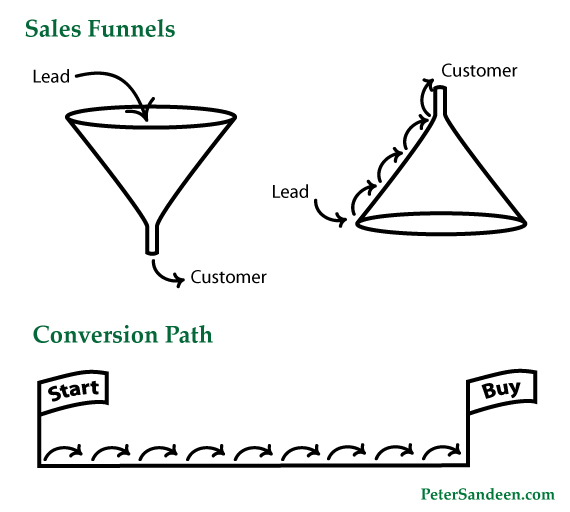
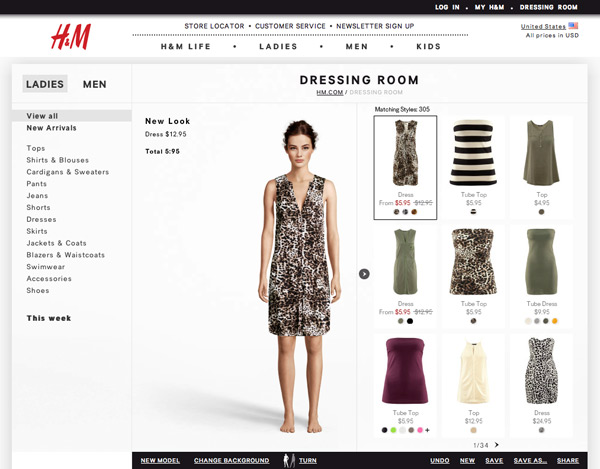
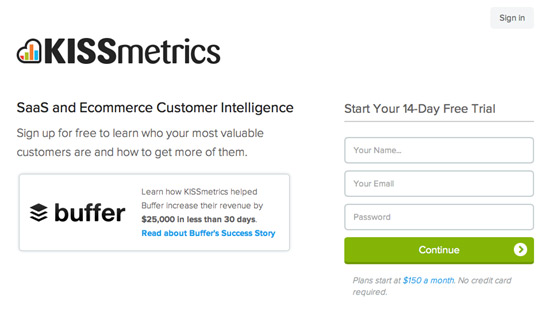
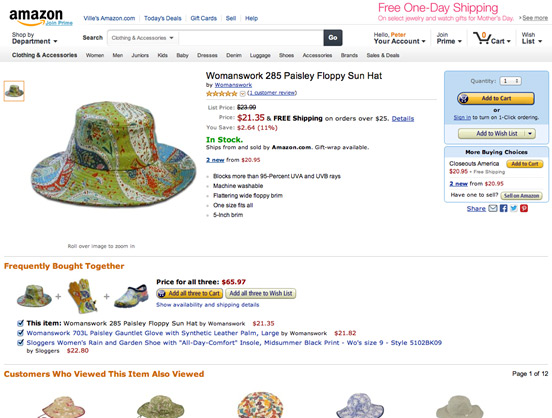
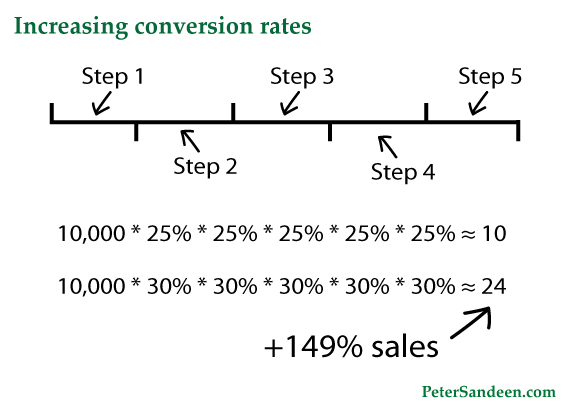
Comments (10)